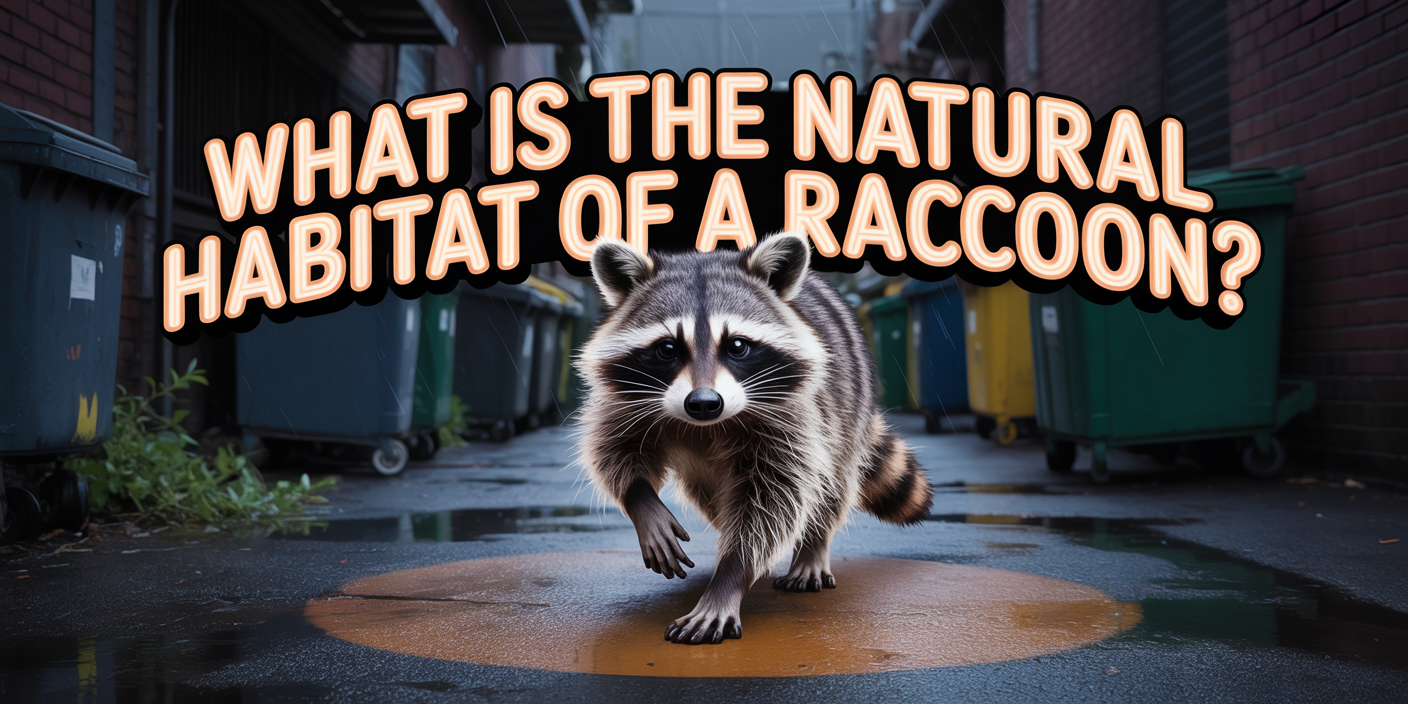“Raccoons thrive in wooded areas near water, but in Palm Bay, FL, they’re equally at home in neighborhoods, storm drains, and under decks. Their adaptability makes any spot with food and shelter a potential den.”
If you’ve spotted raccoons near your home in Palm Bay, you’re not alone. These masked critters are clever, curious, and surprisingly resourceful when it comes to finding a cozy place to live. While raccoons are native to wooded environments, they’ve become experts at thriving in urban and suburban neighborhoods throughout Florida.
Their ability to adapt has made them a familiar sight near trash bins, under decks, and even in attics, especially in areas like Lockmar, Turkey Creek, or anywhere close to water. Understanding the natural habitat of a raccoon is key to keeping them from turning your property into their next nesting site.
At AAAC Wildlife Removal, we’ve helped plenty of Palm Bay homeowners get rid of raccoons quickly and humanely, and it almost always starts with a good hiding spot and easy access to food. This article breaks down where raccoons truly belong, how they adapt to city life, and what you can do to keep them from settling in your backyard. Let’s explore where these clever creatures call home, and how to draw the line at your doorstep.
Learn more: What are the physical characteristics of a raccoon?
What Is the Natural Habitat of a Raccoon?
Raccoons may show up in your neighborhood, but their true natural habitat is far from sidewalks and garbage bins. These animals evolved to live in lush, resource-rich environments where food, shelter, and water are easy to access. In Palm Bay, FL, the warm climate and variety of ecosystems give raccoons plenty of ideal places to settle, even before they venture into suburban yards.
Common natural raccoon habitats include:
- Deciduous forests
These wooded areas are full of hollow trees, brush, and ground cover, perfect for raccoons to climb, hide, and nest. The tree canopy provides safety from predators while the forest floor offers a buffet of insects, nuts, fruits, and small animals. - Wetlands and marshes
Florida’s wetlands are prime territory for raccoons. Shallow waters and dense vegetation create excellent foraging grounds. Here, raccoons can hunt for frogs, fish, crayfish, and waterfowl eggs, all while remaining hidden from view. - Riverbanks and lakesides
Raccoons love water, not just for drinking but also for catching food. Along the banks of the Indian River or Turkey Creek, they can dig through mud for snails or tiptoe into shallow water to snatch a fish. Water access is one of the biggest draws for wild raccoons. - Cypress swamps
These uniquely Floridian habitats are dense, damp, and difficult to navigate, which is exactly why raccoons like them. The thick root systems and standing water make great protection from larger predators, and there’s always a steady supply of plant and animal matter to feed on. - Mangrove forests
In Palm Bay’s coastal zones, mangroves are like natural fortresses. Their tangled roots offer cover, and their proximity to brackish water means a diverse diet of crabs, shellfish, and fruit. These areas are especially appealing during the hot months.
Each of these habitats supports the raccoon’s needs while giving them space to roam without much human interference. However, as urban development grows into their territory, raccoons are increasingly adapting by moving closer to homes, often finding your backyard just as comfortable as a swamp.
How Raccoons Adapt to Urban Areas Like Palm Bay?
Urban Environments as Extended Habitat
Raccoons are naturally suited for forests and wetlands, but they’ve quickly learned to treat cities like Palm Bay as just another version of the wild. Neighborhoods provide easy access to food and shelter, which often makes them more appealing than their traditional habitats. These animals are opportunistic and will adjust their habits to fit their surroundings.
Common Urban Hideouts in Palm Bay
In residential zones like Port Malabar and Turkey Creek, raccoons are often found nesting in crawl spaces, attics, chimneys, and under decks. They may also use abandoned sheds, dense shrubs, or even empty storage bins as makeshift dens. These areas offer warmth, safety, and proximity to human activity without much risk.
Storm Drains and Canals as Travel Routes
Palm Bay’s stormwater systems and canals give raccoons protected paths to roam across neighborhoods undetected. These drainage networks not only provide water but also serve as hunting and scavenging grounds. Raccoons will often use these routes to reach homes, parks, and open dumpsters.
Attractants Around Homes
Urban raccoons are drawn to unsecured trash, pet food, bird seed, compost piles, and backyard water features. Even fruit trees or chicken coops can invite them in. Once they find a reliable food source, they’re likely to return night after night, turning your property into a regular stop on their route.
What Do Raccoons Look for in a Habitat?
When choosing a place to settle, raccoons are surprisingly picky. Despite their reputation as scavengers, they follow a clear checklist of habitat features that help them survive and thrive. In Palm Bay, both natural and suburban areas can meet these needs if the conditions are right.
Whether they’re in a mangrove forest or under someone’s porch, raccoons look for a few specific essentials that make a space livable. Key features raccoons seek in a habitat:
- Consistent food sources such as fruit trees, insects, garbage bins, pet food, or bird feeders.
- Nearby water from ponds, creeks, storm drains, or irrigation systems for drinking and hunting.
- Safe, dark shelter like hollow trees, attics, crawl spaces, or abandoned sheds for resting and raising young.
- Cover from predators and humans using thick shrubs, fencing gaps, or overgrown yards for stealth movement.
These features combined allow raccoons to stay comfortable, protected, and well-fed, whether they’re in the middle of the woods or a backyard in Palm Bay.
Why Raccoons Choose Your Property?
Raccoons are quick to settle wherever they can find easy meals and a safe place to rest, and residential properties in Palm Bay often provide both. Homeowners may not realize that leaving pet food outside, keeping trash bins loosely sealed, or planting fruit trees can turn a quiet yard into a raccoon’s favorite spot.
Even bird feeders and compost piles act as unintentional invitations, especially when food becomes scarce in their natural habitat. These animals are incredibly food-motivated, and once they find a reliable source, they’ll keep coming back.
Shelter is the second big draw. Raccoons are always on the lookout for quiet, protected places to nest and raise their young. Attics, crawl spaces, sheds, and even gaps under porches can become raccoon dens if left unsealed.
In neighborhoods with dense landscaping or overgrown corners, raccoons have plenty of cover to move around undetected. Combined with Palm Bay’s mild climate and abundant water sources, these conditions make it easy for raccoons to turn a backyard into a permanent home.
How to Make Your Property Less Appealing to Raccoons?
If raccoons are treating your home like an all-inclusive resort, it’s time to make some changes. The key to deterring raccoons is removing the features that make your property attractive in the first place. By cutting off their access to food, shelter, and water, you’ll make it far less likely they’ll stick around.
These steps are simple but highly effective when applied consistently across your yard and structures. Steps to deter raccoons from your property:
- Secure your trash cans with tight-fitting lids or animal-proof locks.
- Bring pet food indoors at night and avoid leaving bowls outside.
- Seal entry points to attics, crawl spaces, and sheds with durable materials.
- Trim overgrown vegetation to reduce hiding spots and denning areas.
- Remove fallen fruit from trees and fence off vegetable gardens if needed.
- Use motion-activated lights or sprinklers to scare off nighttime visitors.
These proactive steps send a clear message that your property isn’t open for raccoon business. While raccoons are smart and persistent, they’ll usually move on if the effort outweighs the reward. And if the problem continues, it might be time to call in local professionals like AAAC Wildlife Removal for a humane solution.
Raccoon Habitats and the Law in Florida
In Florida, raccoons are considered a nuisance species, but they’re still protected under state wildlife regulations. Homeowners are not allowed to trap, relocate, or harm raccoons without following the proper legal procedures.
The Florida Fish and Wildlife Conservation Commission (FWC) requires that all trapping and removal be done humanely, and in some cases, only licensed professionals are authorized to handle these situations. Palm Bay residents who try to deal with raccoons on their own could unintentionally break the law or create a bigger problem.
Improper relocation can spread disease, separate mothers from their babies, or lead raccoons to return. That’s why calling a licensed wildlife removal expert like AAAC Wildlife Removal is the safest route. We’re trained to assess raccoon activity, follow state regulations, and remove animals humanely, while also helping you prevent future issues around your home.
Why Raccoon Habitat Awareness Matters?
Knowing where raccoons naturally live, and how they adapt, is the first step to protecting your home and property. When you understand what draws them in, you can take the right steps to reduce the appeal of your yard and avoid the headaches that come with raccoon infestations.
It also helps you respond sooner when you see the early warning signs of nesting or scavenging activity. Beyond home protection, habitat awareness also supports healthier human-wildlife interactions.
Raccoons are part of Florida’s ecosystem, and when they’re displaced or forced into urban areas, conflicts with people increase. By managing attractants and securing your home, you’re helping maintain balance for both your family and the environment. It’s a simple but powerful way to stay safe, avoid property damage, and protect local wildlife.
Need Help with Raccoons in Palm Bay? Call AAAC Wildlife Removal
If raccoons are causing trouble around your home in Palm Bay, you don’t have to handle it alone. At AAAC Wildlife Removal, we specialize in safe, humane raccoon removal and habitat prevention services. From noisy attic dwellers to backyard invaders, our team knows exactly how to identify problem areas, seal entry points, and keep raccoons from coming back.
We proudly serve the entire Palm Bay area, including nearby neighborhoods like Malabar, West Melbourne, and Grant-Valkaria. Whether you’re hearing strange noises at night or spotting overturned trash bins in the morning, give us a call. We’ll restore peace to your property and help you stay raccoon-free for good!




